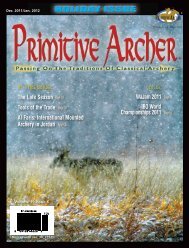In This Issue: plus: - Primitive Archer Online
In This Issue: plus: - Primitive Archer Online
In This Issue: plus: - Primitive Archer Online
Create successful ePaper yourself
Turn your PDF publications into a flip-book with our unique Google optimized e-Paper software.
Selfbows<br />
What is a selfbow? One solid piece<br />
of wood, carved from a tree and<br />
finessed into an arc. The journey<br />
to the final product is just as important to me<br />
as the finished bow. That is obviously the<br />
bowyer in me talking. Many people who<br />
shoot selfbows never see the bow in stave<br />
form or have any idea what tools were used<br />
in its construction. I don’t consider myself a<br />
purist by any means. I use many traditional<br />
tools and techniques in making bows,<br />
arrows, and points, but I don’t craft my bows<br />
with flakes of chert or sandstone blocks.<br />
There may be an undefined line between a<br />
“Traditionalist” and a “Purist.” <strong>In</strong> whatever<br />
category I may fall, one thing is for certain—<br />
I love my hand tools!<br />
I see many pictures of folks building<br />
bows with band saws and other power tools.<br />
I don’t shun or put down anyone for using a<br />
power tool. I’m not arrogant enough to tell<br />
someone that they are not doing it correctly.<br />
That which is correct is that which best takes<br />
you down the road to success. I have seen<br />
many a fine bow cut out with a band saw and<br />
even a few cut laser straight on a table saw.<br />
For me, the best approach is through the use<br />
60<br />
and<br />
B y R y a n G i l l<br />
Hand Tools<br />
www.<strong>Primitive</strong><strong>Archer</strong>.com Volume 21 <strong>Issue</strong> 1<br />
of a couple good hand tools, a hatchet, a<br />
machete, and a straight handled<br />
drawknife\scraper. Some would say, “Sure,<br />
it’s easy to say you don’t like a band saw until<br />
you have used one.” Agreed. I do in fact have<br />
one and have used it a few times. There is<br />
something about the whine of the blade and<br />
hum of the motor that is very impersonal to<br />
me. The wood may have taken decades to<br />
grow, and in a few minutes I lop it off with<br />
little effort. Perhaps it’s out of respect for the<br />
wood that I work it by hand. I can appreciate<br />
the wood and the grain as I sweat through<br />
reducing a full stave into shavings and,<br />
eventually, into a floor tillered bow.<br />
The more bows I make, the more I realize<br />
that following the grain is ever important.<br />
Many bows are made with a perfect growth<br />
ring on the back, yet suffer greatly from<br />
excessive grain run-out. <strong>This</strong> is especially<br />
true with Osage. A good bow can actually be<br />
made with a fair amount of grain run-out,<br />
but a better bow would be obtained by<br />
following the grain as closely as possible. I<br />
have noticed that a bow’s “expiration” comes<br />
earlier when the grain is violated. For me,<br />
there is no better way to follow the grain<br />
The right hand side of the stave has been<br />
sawn straight while the left has been hand<br />
split. <strong>This</strong> is often the case with commercially<br />
bought staves. The straight line cut by the saw<br />
clearly cuts through the meandering grain<br />
leaving many places of grain run-out and<br />
encouraging lifted splinters or broken bows.<br />
than with a drawknife. Wood splits off where<br />
it wants to rather than being forced into<br />
compliance with hundreds of sawing teeth. A<br />
stave will tell you a lot if you take time to<br />
watch, feel, and listen.<br />
My favorite way to build a bow is by eye<br />
and feel. I measure a stave and mark center<br />
which can also easily be done with a length<br />
of cordage and dividing it in half. I like a<br />
center mark and that is all. The rest of the<br />
stave won’t have any pencil marks when I<br />
start. I begin by removing the obvious bits<br />
and lengths that will not be in my bow. I use<br />
a sharp machete or a hatchet if the wood is<br />
extra tough. I take plenty of time to “eye<br />
ball” the stave from different directions and<br />
remove wood slowly. As the stave takes a<br />
closer-to-finished form, I switch to the<br />
straight handled drawknife. The slow pull of<br />
the knife should follow the grain well.<br />
Although a dull knife is a great<br />
inconvenience, I have found too sharp a<br />
drawknife will cut through the grain instead<br />
of following it. There is a happy medium<br />
between bluntly splitting the wood and<br />
cutting it. Nothing but practice will tell you<br />
where that medium is.



